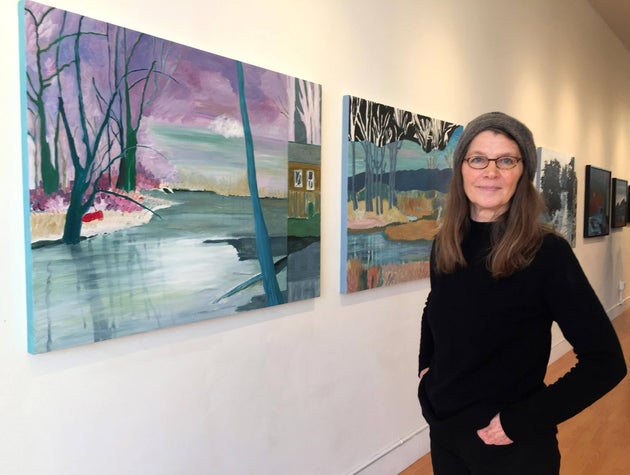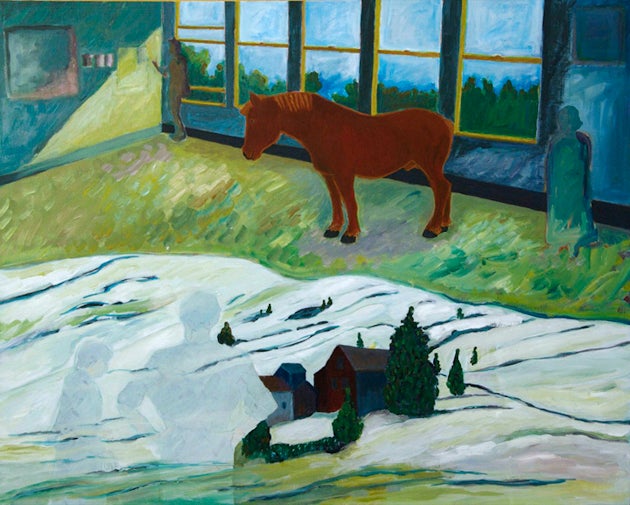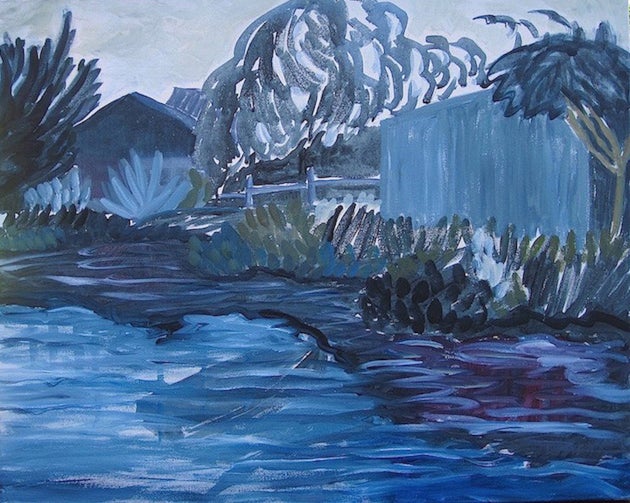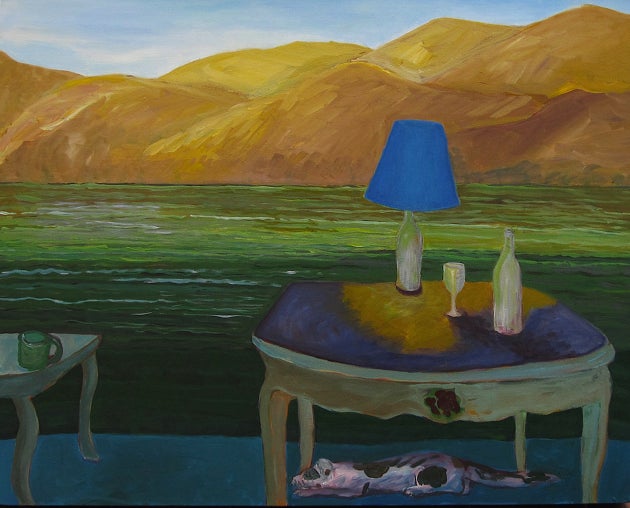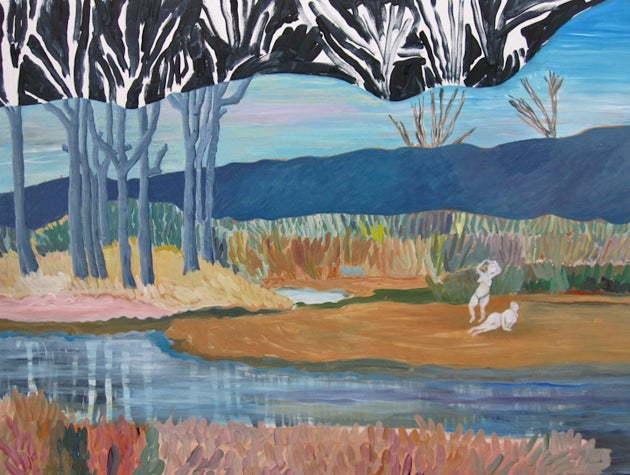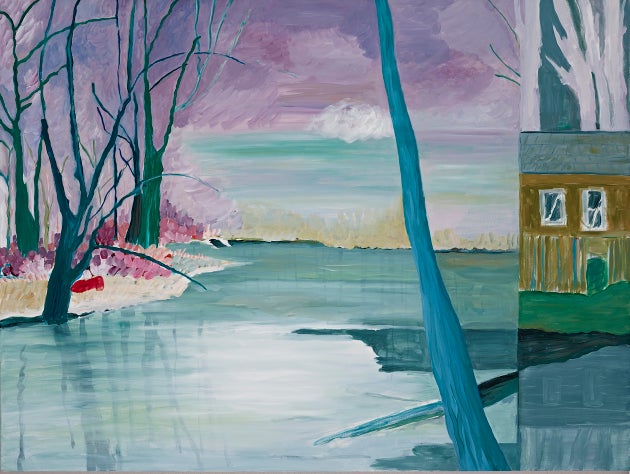PHOTO BY MARK HUBBELL
Painter Janet Norris, whose work is currently on view at the Far Out Gallery in San Francisco, creates personal and poetic images that multiply metaphors and possible meanings. For example, when water appears in her work—as it often does—it may represent a primeval ritual element, a mode of travel, a threat, an escape, a precious resource, or a metaphor for life or death. Norris’ open-ended narratives, although told gently, often embody risks, dangers and transformations.
John Seed Interviews Janet Norris
JANET NORRIS
Where did you grow up and how did your childhood shape you?
Our family moved at least a half dozen times during my younger years and two of them remain strong within me today. Both were cattle ranches with what I think of as Big Nature qualities. My father was a purebred Hereford breeding expert. I grew up in an alcoholic household in which there was a lot of chaos. However, I recall my youth as being a magical time, even a very good time.
To avoid the unpleasantness of my parents’ tangled relationship my brother and I often escaped into the wilds of nature. One time we walked up a mountainside path that wound its way through a forest above the Snake River, near Jackson Hole, Wyoming. We suddenly came upon a small pond that appeared very dark, so black in its depths that it frightened us. For me, it was like a secret circle of magic. I regulariy read the short stories by the German speaking Swiss writer, Robert Walser, and I think his haunted view of nature is akin to how I felt. Standing there we whispered about how animals must come to drink at evening time, both prey and predator.
Then we scattered for home and later that night I cut off my long blonde Norwegian braids for no apparent reason. Was it a sacrifice to the pond elves? Because of family circumstances, I developed an independent character, with a tolerance for being alone, which has been a boon to becoming an artist later in my life. Nature welcomes the lonely and it feeds a dreamy artist who seeks the visionary and magical. Being with nature is an aesthetic experience for me, and the idea has been confirmed by the work of many writers as well as artists.
JANET NORRIS
When did you realize that you were an artist?
We were very poor. There were no books in our homes but it was about age nine or ten that a teacher began to give me pages from a book that she’d evidently cut out of a text on Renaissance art. She fed them to me, one at a time. I think she saw me drawing—scribbly drawings, nothing special, and perhaps she knew of my home situation. I wondered if I’d ever be able to do more than to try my best to draw some little things I saw around me. I very much doubted it.
JANET NORRIS
How did your art develop in college and who were your mentors?
I began studying art at Drake University in Des Moines, Iowa. A class with a Professor there would be the last time I experienced a skills-based course, because most of the rest of my coursework during the 1970’s was based more on theory. And, I loved every single class! It was once more a familiar opportunity to be independent — a no holds barred situation. However, I had teachers who practically used ArtForum as a textbook – that wore on me after a time. I researched on my own, finding an artist like Agnes Martin, and inspired by her, made grids on paper that I thought referred back to nature.
In a tremendous contrast of styles, I nearly died of admiration for the work of Anselm Kiefer, with all the grit in it. Being inspired by him and other Earth artists, I used latex to create large format pieces into which I embedded dirt and pebbles. I don’t think I had a mentor in the usual sense. I had professor friends. My graduate committee left me to find my own way. Throughout the education process everything I was attracted to had an underlying connection to nature.
I eventually studied Zen Buddhism, a philosophy that enhanced my view of existence. After some years, nature for me included artists such as Pierre Bonnard and Elmer Bischoff, from whom I gained an understanding of nature translated into lush color. From Edvard Munch and David Park, I understood the power of passion and the expression of the human psyche.
JANET NORRIS
Is it fair to say that Joan Brown’s work was a major influence on you?
Yes, one of the artists I was strongly attracted to was Joan Brown. I am a bit of a primitive, and so was she. She influenced me, although indirectly, to make outsider art or folk art for a few years rather than through her own work-a way for me to make a break from the art academy au courant styles. I have always loved the repetitive patterning of folk art, and I feel a strong resonance with the crazy insights of outsiders. Joan’s simple, figurative narratives are especially appealing to me, those of her home life, her swim life, the patterns, the dog, etc., during the time when she was not using the thick painterly impastos she began with as a member of the Bay Area Figurative movement.
In recent years I’ve added two contemporaries, the Canadian and long time Londoner, Peter Doig and the Swede, Karen Mamma Andersson, to my list of influences. I have tried many styles before recently becoming aware of what I wanted to paint and it was only about ten, perhaps twelve years ago that Doig and Andersson came into view. It seemed to me that they gave me permission to use nature in a significant way, not as landscape – I was not interested in conventional landscape, but as a way to meditate on nature, to use it as a contrast between it and culture. Both have been influenced by Munch, so that was a nice connection. I am much “gentler”, though, and not inclined to make in-your-face images like Andersson sometimes does, when she carries Munch’s ideas to the edge. Doig was influenced by the Canadian Group of Seven who were fantastic “expressionist” landscape artists, and he sometimes haunts the forests in a way I can relate to.
JANET NORRIS
Tell me about one or two of the paintings in your current show.
I want to interject my working process here. Many of my paintings depict unlike combinations, i.e., nature/culture contrasts - because that’s the way they “happen” to me. My work method involves a chance thought, something I read, or saw, or heard, followed by the realization that I may have a painting to do. I collect images from the internet and place them in a digital folder: water scenes, hills, trees, boats, humans, animals, etc., are among images I finally sketch onto the canvas. I usually create the painting in my imagination, carrying it around in my head for days or weeks before I begin to make a drawing on the canvas. I think of the images which are projected on the canvas as an armature to get the work started, but it soon disappears as the painting process cancels out its intentions in a flurry of exciting color application. I often leave stray pencil marks behind, or a fragment of canvas showing through.
JANET NORRIS
The “Remembrance of Past Times” painting presents a paradise. The color complements were very carefully considered to exude beauty. How to represent the “lostness” of paradise occurred to me in a flash one day as I was looking at the canvas, brooding on my not completely fleshed out idea – how to do the culture/nature contrast for this one – was the question I needed to answer. Suddenly, I realized that I needed to leave the top area as a crudely painted, perhaps dystopic, future. Many recent paintings reference the degradation of our environment as this one does.
JANET NORRIS
“Losing It” is about anxiety. The painting “arrived” in my mind, to begin with, with the general idea of trees invading a bedroom on the left (one is unsure of their position in the space), and expanded to a mirror to the right of the bed, with liquid or water dripping down its surface onto a not so firm floor. A woman, reflected in a mirror, is behaving in a strange manner performing a ridiculous, unknown task. This older painting, of perhaps six years ago, was made when I had the mental space (with no political worries) to make a work that was more infused with itself, with its quirks and worries and strange narratives that needn’t be explained. You could laugh with it if you wished, or scratch your head.
JANET NORRIS
What are some of the “flavors” that color your approach to painting?
I need to be alone for hours, before and during the work process. I could not work in a shared studio space because I couldn’t concentrate, couldn’t get into the act of painting.
What are your interests outside of painting?
American roots music such as Delta Blues, country musicians like Merle Haggard and bands like The Band with Bob Dylan. And my two daughters and their families, neither of whom are local, but there is “an app for that” by which we can communicate whenever we wish. I love walking, observing nature with my pocket size camera, and constant reading: novels, short stories, history, art history, biographies, art reviews, blogs, literary newspapers, etc.
Janet Norris: Living Dangerously
Exhibition Dates: February 4 – February 25, 2017
Open: Thursday - Saturday 12 to 6 pm, or by appointment
3004 Taraval Street
San Francisco, CA 94116

